Delivering enough homes to meet need will be critical to Guildford’s continuing economic success
Where are the homes going to go?
It is clear that Guildford and its surrounding local authorities haven’t built enough homes in recent years. In order to better compete with the likes of Oxford and Cambridge, and competitor towns like Bedford and Aylesbury, Guildford simply has to build more homes.
With little delivery currently from large sites, new development has been dominated by small rural sites and town centre redevelopment, including some office to residential permitted development, although this has been limited with continued demand for offices in Guildford.
Further town centre intensification with repurposed retail units adapted to the changing requirements of the sector presents opportunities to provide homes alongside. 863 homes are earmarked for Guildford town centre in the Local Plan, 9% of the total. 400 of these are allocated at M&G’s North Street redevelopment. The potential closure of Debenhams would also provide a good opportunity to open up the river with Guildford likely to embark on a revised Town Centre masterplan.
Woking has shown the way in recent years, with the highest rate of housebuilding. With Green Belt being a major obstacle to finding land in order to build, the local authority has chosen to intensify land uses within the town centre, with multiple towers currently under construction up to 35 storeys in height.
There is little appetite for going tall in Guildford itself, with a number of proposals having seen heights reduced to get through planning in recent years. Focus is starting to shift to taking a more pragmatic approach to green belt release.
A conundrum facing local authorities is reconciling the required growth and infrastructure with Green Belt boundaries, some of which have not undergone review for decades. Guildford’s recently adopted plan proposed circa 1% release of Green Belt to achieve the stepped increase in growth. Waverley sought to release some Green Belt, in part to protect the more sensitive parts of AONB.
Runnymede’s Local Plan is seeking modest Green Belt release in response to this challenge, soon to be followed by Elmbridge’s emerging Local Plan. The options consulted include potential releases in those areas deemed to be of lower quality Green Belt. Surrey Heath will decide on the exceptional circumstances to make any Green Belt release in January 2020, in the knowledge that the alternatives could be development closer to the environmentally sensitive Thames Basins Heath SPA. National government is keen for Green Belt protection, and will continue to defer the decision on release to local authorities, who also have to promote growth and sustainable patterns of development.
Mapping Local Plan status and five-year land supply across this area
Guildford’s recently adopted Local Plan (although it is in Judicial Review process) proposes a five-year housing land supply of 5.93 years. This is a vast improvement from the 2.5 years in the previous estimate, prior to the new Local Plan, and is clearly a positive step in the right direction.
Sites include urban extensions to Guildford, including Blackwell Farm, Gosden Hill Farm, and a new settlement of over 2,000 homes at the former Wisley Airfield, all of which will see green belt release, but this Plan will only be finally confirmed following a High Court challenge.
The infrastructure puzzle
As part of the new Local Plan, a number of large strategic sites have been allocated to come forward for housing. For these to happen, infrastructure improvements are necessary to enable housing delivery.
Railway upgrades
Guildford station has plans for additional platforms and layout changes to provide additional capacity, along with a new station building, 438 new homes, retail, office space and improvements in the public realm. Planning was approved in February 2018. An enhanced station environment and interchange and connections with the town centre has the potential to bring forward and encourage adjacent development, especially around the River Wey, where other sites are allocated in the Local Plan.
New railway stations
Guildford could see two new stations built at Guildford East and Guildford West. The latter is allocated in the Local Plan, adjacent to the Royal Surrey County Hospital and close to the Blackwell Farm site, an allocated site owned by the University of Surrey that has plans for a mixed-use urban extension that will see 1,500 homes built and an extension to the University’s Research Park.
At Guildford East, landowner Martin Grant Homes is promoting a potential station adjacent to the allocated 1,700 home site at Gosden Hill Farm. Network Rail considers that, subject to further assessment and approval, the railway station is feasible and viable.
Road upgrades
A major upgrade to the Wisley interchange, where the M25 and A3 meet is planned with cost estimates of up to £250m. The DCO for this scheme is progressing and is likely to be made in Autumn 2020. This upgrade is necessary to bring forward nationally important infrastructure and to enable the Local Plan growth.
£30m+ upgrades to junctions on the A3 are also needed to mitigate the impact of strategic sites including 550 homes planned at Garlick's Arch. These are to be wholly developer-funded between 2021 and 2027.
Ash Road bridge
A new bridge over a railway line is needed before a further 700 new homes can be delivered at Ash and Tongham. The scheme has provisionally secured £10m in funding from Homes England and £2.5m from Network Rail. Guildford Borough Council is seeking to secure further contributions from Surrey County Council and S106 funding from developers.
Read the articles within Guildford: Driving Surrey below.
.jpg)

